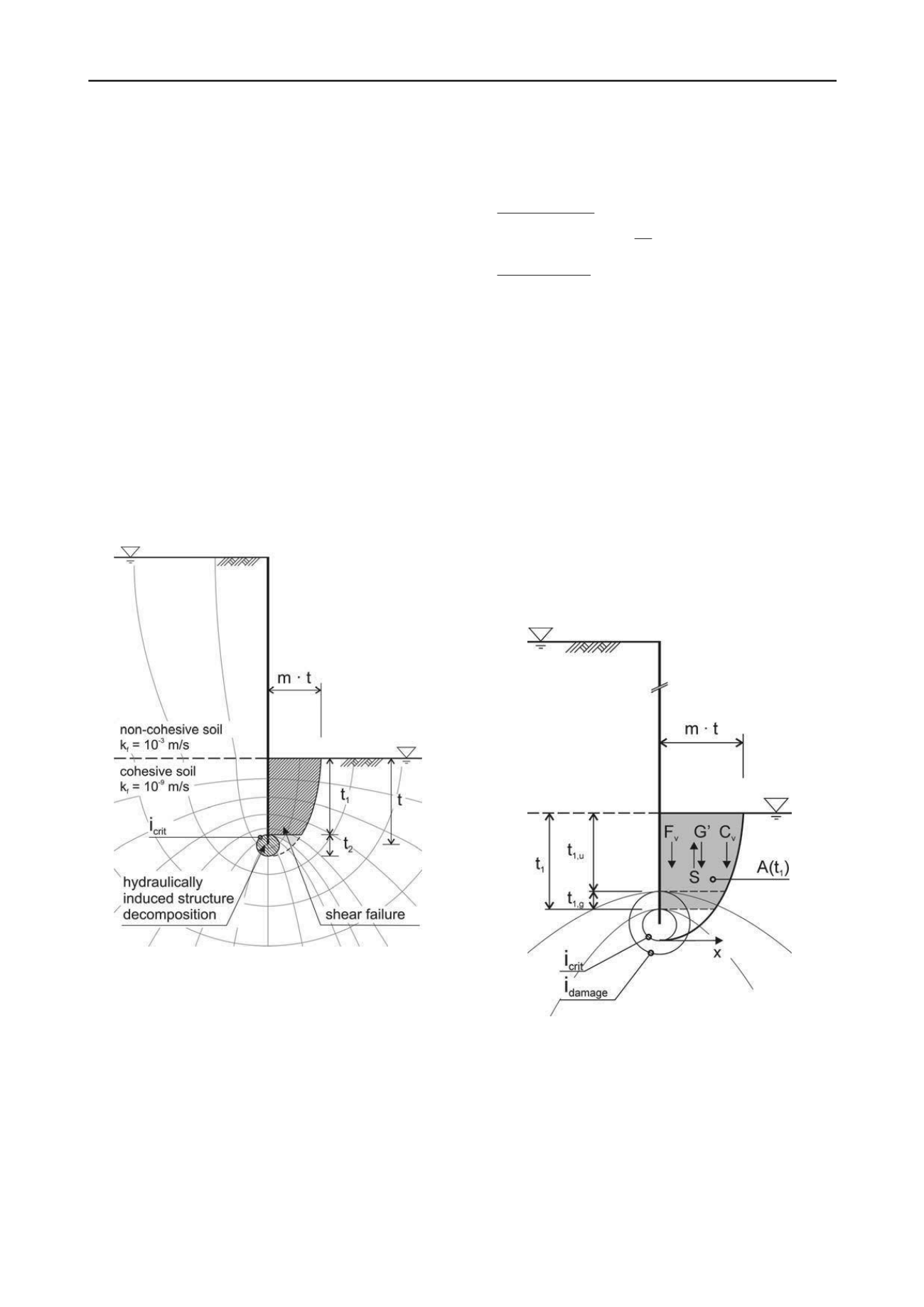
451
Technical Committee 101 - Session II /
Comité technique 101 - Session II
limit state of the hydraulic heave. Considering a construction
state depending flow distribution and a valid limit value of i
crit
there is a failure area, which can be distinguished as hydraulic
induced structure decomposition and shear failure. Therefore
the failure process consists of two phases, the structure
decomposition followed by shear failure.
4 RECOMMENDATION OF A DESIGN APPROACH
4.1 Reference volume
The definition of a representative reference volume is essential
for transferring the typical failure sequence of hydraulic heave
in cohesive soils to the design approach. For a failure process
given resistance activation the spatial arrangement of the
resistances shall prevail.
The reference volume is based on the flow situation, which
can be determined by the construction state and the soil
stratification. The areas of hydraulically induced structure
decomposition of the soil, as well as of shear failure are defined
as part of the reference volume (Figure 2). The outer boundary
of the reference volume is represented by the flow line, which is
tangent to the curve of i
crit
. For determination of the shear body,
the relevant flow line is approximated as a parabolic function. A
widening of the reference volume beyond the base of the wall,
can only occur if i
crit
is realized by the given flow situation.
Figure 2. Areas of dominant shear failure and hydraulic induced
structure loss at a flow around pit wall
4.2 Hydraulic induced soil structure decomposition
In the first step of safety analysis against hydraulic heave in
cohesive soils, the maximum possible hydraulic gradient max i
relevant for soil structure decomposition is estimated. Max i is
related to a construction stage and has to be compared with soil-
specific i
crit
.
The approach aims to identify a critical hydraulic loaded soil
area. For the relevant part of the reference volume in the
subsequent shear failure analysis no resistances are activated.
Basic idea of the proposed design approach is the assumption of
continuously decreasing shear strength of the soil in dependency
of increasing hydraulic gradient. In the second step, the shear
failure analysis, reduced shear resistances can be considered.
To analyze possible soil damage and soil structure
decomposition, the following relationships have to be
investigated.
Damage criterion
crit
damage
w
i
max i i
(3)
Failure Criterion
crit
max i i
(4)
Soil damage starts when the effective stress disappears due
to the hydraulic impact. This occurs first when
'
3
≤ 0. Here the
potentially shear failure body has to be identified. Depending on
the size of max i, i
damage
and i
crit
different results of the reference
volume are possible.
4.3 Shear failure
As second part of the design approach the analysis of the safety
against shear failure must be considered. The analysis is
performed on the soil body remaining after the possibly
hydraulic structure decomposition of the soil continuum. For the
calculation a time-consistent failure state is valid, i.e. it is
necessary to provide a strict separation of drained and undrained
soil properties and flow conditions.
The stability of the reference volume to shear failure is
determined by the following equation.
v
S G C F
v
(5)
Figure 3. Parameter definition – shear failure
The limit state analysis is carried out as a balance of vertical
forces of the flow impact and the acting resistances at the
reference volume (Figure 3). Resistances are represented by the
buoyant soil weight G’, the shear resistance acting at the shear
surface C
v
and the bracing acting at the pit wall F
v
.
The resistance of soil weight is determined by the submerged
unit weight of the soil
' and the area of the shear body A(t
1
). To
determine the soil weight a consideration of soil damage is
generally not required. As a conservative assumption a
consideration of hydraulic resistances from damaged soil areas
can be dispensed. For the calculation a shear body height of t
1,u
is decisive. For example in a construction state with no filter


